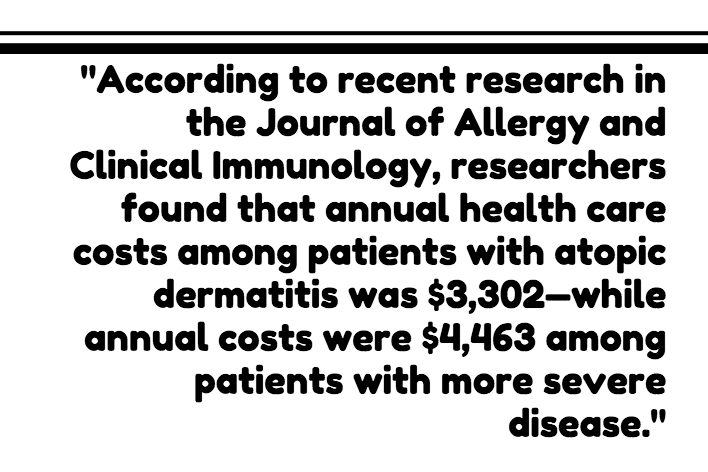ADVERTISEMENT
Atopic Dermatitis: Value Gained Through New Treatments
Recent advances in the ability to treat moderate-to-severe atopic dermatitis with targeted therapies have changed the game for these patients. However, cost considerations could significantly impact budgets as these new agents come to the market.
Understanding the Burden
Chronic, lifelong atopic dermatitis represents 3.2% of adults in the United States, and has a potential patient population of around 400,000 adults, according to recent data presented at the AMCP 2017 Annual Meeting. The disease is most common in children but persist into adulthood for 50% of patients.
Additionally, atopic dermatitis is associated with increased health care utilization and costs across, with significantly increased costs among patients with severe disease. According to recent research in the Journal of Allergy and Clinical Immunology, researchers found that annual health care costs among patients with atopic dermatitis was $3,302—while annual costs were $4,463 among patients with more severe disease.
Likewise, research published in Advances in Therapy found that patients with atopic dermatitis have a higher comorbidity burden, higher health care utilization, and higher costs compared to non-atopic dermatitis patients.  The researchers studied commercial, Medicare, and California Medi-Cal claims data and determined that these patients used $16,914 in health care services per year under Medicare. They also found that these patients had higher risk for asthma and allergic rhinitis.
The researchers studied commercial, Medicare, and California Medi-Cal claims data and determined that these patients used $16,914 in health care services per year under Medicare. They also found that these patients had higher risk for asthma and allergic rhinitis.
Standard of Care
Typical treatment options for atopic dermatitis include topical corticosteroids, calcineurin inhibitors, non-steroidal and anti-inflammatory agents. One-year prevalence of the disease affects 10.2% of adults in the United States—and often these patients receive one of these topical agents as a first-line treatment.
Persistent, moderate to severe atopic dermatitis impacts 20% to 46% of adult patients with the disease. If these patients do not respond to topical therapy, short-term phototherapy with ultraviolet radiation can be used to treat the disease.
Research indicates patients with uncontrolled atopic dermatitis that still have no response to phototherapy are often treated off-label with generic immunosuppressants such as cyclosporine, azathioprine, methotrexate, and mycophenolate mofetil. However, these drugs are not indicated for use in patients with atopic dermatitis and can produce serious adverse events.
Approval of Eucrisa
Severe side effects associated with broad immunosuppressants highlighted the need for more targeted therapies with fewer systemic and cutaneous side effects.
In December 2016, the FDA approved Eucrisa (crisaborole; Pfizer) to treat mild to moderate atopic dermatitis in patients aged 2 years and older. The drug is a topical ointment that includes a a phosphodiesterase 4 (PDE-4) inhibitor. According to research in the Journal of the American Academy of Dermatology, PDE-4 activity is increased among patients with atopic dermatitis and targeting PDE-4 reduces the production of proinflammatory mediators in these patients. PDE-4 inhibitors also have reduced adverse event profiles, with burning during application as the only prominent side effect.
A recent report from Spherix Global Insight indicated that 90% of dermatologists have adopted use of Eucrisa since its approval. The average list price for Eucrisa is around $580 for a 2 ounce tube. Pfizer has stated that it anticpates around $2 billion in annual sales for the product. However, in a recent cost-effectiveness report, ICER was unable to establish a value-bench mark or cost-effectiveness rating for the drug based on a lack of substantial clinical data.
Approval of Dupixent
In March of 2017 the FDA approved Dupixent (dupilumab; Sanofi/Regeneron), a subcutaneous treatment for moderate-to-severe atopic dermatitis. Dupixent could have a significant impact on spending, considering its $37,000 price tag and large patient population, which will have to stay on the drug long term in order continued disease relief. However, according to clinical trials, only about 25% of patients on Dupixent meet the responder criteria.
Additionally, recent reports indicate that uptake of Dupixent is high among dermatologists, suggesting that the drug will likely have a significant spending impact in 2018.
A cost-effectiveness report from ICER found that Dupixent provides good value at its current price and is cost-effective. Dupixent’s costs fell within the ICER threshold of $50,000 to $150,000 per quality-adjusted life-year(QALY)—at $101,800 per QALY.
Additionally, Dupixent is expected to receive FDA approval for treatment of severe asthma, which could also benefit patients with atopic dermatitis given the increased risk for asthma comorbidities among these patients.
For articles by First Report Managed Care, click here
To view the First Report Managed Care print issue, click here





















